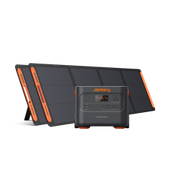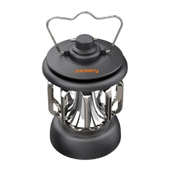Whenever someone wishes to move to a more sustainable source of power, they often wonder how many amps a refrigerator uses so they can make a well-informed decision. A standard household refrigerator uses between 3 to 6 amps, and a large commercial refrigerator can use up to 15 amps or more.
Understanding the energy consumption of a refrigerator, mini fridge, and large freezers is crucial if you are considering alternative power sources to save on your monthly electricity bills. Additionally, understanding and a thorough knowledge of how to calculate your refrigerator's energy use can help you save money in the long run.
If you are looking for alternative ways to power up your refrigerator or portable freezer, you can go ahead with Jackery Solar Generator. The portable and lightweight solar-powered generators are easy to carry and help you power your refrigerator for long hours.
Key Takeaways
- A standard refrigerator typically uses 3 to 6 amps, while larger commercial units can draw up to 15 amps or more. Startup amps for refrigerators are often significantly higher, temporarily reaching 15-20 amps.
- To calculate the refrigerator's amps, you can use the formula Amps = Watts ÷ Volts, check out the manufacturer's website, or install a power meter to get accurate readings.
- There are various ways to reduce your electricity bills, such as setting the correct temperature, cleaning compressor coils, and ensuring proper ventilation.

How Many Amps Does a Refrigerator Use?
A standard refrigerator, which most households use to store food and beverages, uses 3 to 6 amps when operating. The amp used directly depends on the refrigerator's size, efficiency, and age. For instance, large models used for commercial purposes can draw up to 15 amps or more.
Furthermore, it is important to understand that medium - to large refrigerators and portable freezers may briefly draw more current, which often reaches 15 to 20 amps before it settles down into a standard running amperage.
Definition of Amps, Volts, Watts, Running Watts
In order to answer how many amps a fridge uses, it is crucial to get acquainted with the basic technical terminologies. These terms will also help you answer how many amps a refrigerator draws on startup and how you can calculate your refrigerator's energy.
Amps (Amperes): Amps are the unit of electric current that helps measure electricity flow through a circuit. In short, Amps indicates the amount of electricity a device uses. Amps can be calculated using the following formula:
Amps = Watts ÷ Volts
Volts (Voltage): Volts are the potential difference that drives the electric current through a circuit. If you are new to understanding how many amps a deep freezer uses, consider volts as the "pressure" pushing the electrons.
Watts: Watts is the unit of power, which represents the rate at which any appliance consumes or produces electrical energy. A wattage is a product of volts and amps, and is represented by W and can be calculated using the following formula:
Watts = Volts × Amps
Running Watts: As the name suggests, running watts are the continuous power required to keep an appliance operating. In most cases, it is usually lower than the startup watts, which are needed only momentarily when a refrigerator is turned on. You can use the following formula to identify the running watts of any appliance:
Running Watts = Volts × Running Amps
If you are interested in learning more about amps, watts, and volts, check out the ultimate guide, which elaborates on each of the basic units of electricity in detail.
How Many Amps Does a Mini Fridge, Freezer, or Refrigerator Use?
There are different types of refrigerators, freezers, and mini-fridges available in the market that draw different amounts of power. At the same time, their amp usage can also vary based on their size, power efficiency, and operating conditions. Here's a detailed breakdown of the typical amperage for each type of refrigerator, along with an explanation of how to calculate the actual amps refrigerators use. You can also learn how many watts does a refrigerator use here.
|
Refrigerator Types |
Refrigerator Wattage |
Actual Energy Usage (Around ⅓ of refrigerator wattage) |
Amps (= Watts / Volts) |
|
Mini Fridge |
50W to 100W |
16W to 34W |
0.42 to 0.83 amps |
|
Household Refrigerator |
500W |
167W |
1.39 amps |
|
Standard Refrigerator |
100W to 800W |
33W to 266W |
0.83 to 6.67 amps |
|
Freezer |
100W to 400W |
33W to 133W |
0.83 to 3.33 amps |
|
Large Commercial Freezer |
700W to 2000W |
233W to 667W |
5.83 to 16.67 amps |
|
Energy-Efficient Refrigerator |
150W to 300W |
50W to 100W |
0.42 to 0.83 amps |
How Many Amps Does a Refrigerator Draw on Startup?
When your typical standard 480W refrigerator first starts, it could momentarily draw 1440W of power and 24 amps, but once running, it will stabilize at 480W and draw only 4 amps.
As you can see, when a refrigerator is first turned on, it draws significant power that it usually requires during normal operational time. This initial power surge is extremely important to start an idle compressor. This power surge, known as startup amps, can be several times higher than the normal running amps.
Startup Watts vs. Running Watts
The startup watts refer to the amount of power required to start the refrigerator's compressor when it is sitting idly. The startup watt's value is typically 2 to 3 times higher than the running watts. For instance, if you have a refrigerator at home with a running wattage of 167W, its startup wattage could be as high as 500W.
It should be noted here that this power surge lasts only a few seconds, but your power supply should be strong enough to provide the surge, as it is extremely important to get the compressor and other components of the refrigerator up and running.
Whereas running watts is the power required by the refrigerator once the compressor starts running and the appliance settles into its normal operating mode. These running watts are the refrigerator's continuous power consumption, which lies between 100W to 800W.
In order to understand how to calculate the running and startup wattage, let us assume that you have a typical refrigerator at home that runs at 120V and draws 3 amps.
Running Watts = Voltage x Running Amps = 120V x 3A = 360W
Startup Watts = Running Watts x 3 = 360W x 3 = 1080W
Note: We multiplied the running watts by 3 because the startup watts are typically 2 to 3 times higher than the running watts.
Startup Amps vs Running Amps
Similar to the startup watts, startup amps are also significantly higher when the refrigerator is first turned on. In a few cases, the spike can be as much as 5 to 7 times the normal running amps.
Whereas the running amps is the amp that the refrigerator consistently uses after the initial startup phase, which is significantly lower than the initial surge requirement.
Startup Amps = Running Amps x 5 to 7 = 3A x 7 = 21A
How to Calculate Your Refrigerator Amps
Knowing how to calculate refrigerator amps is important for different reasons. First, it helps you manage your energy consumption. Second, it also helps you analyze whether the unit needs maintenance or a complete replacement.
There are several methods that help in determining the refrigerator amps. The most common method that helps you calculate the amps for your refrigerator.
Method 1: Manufacturer Details -- Energy Star Rating
The easiest and most common way to determine the refrigerator's amp is to check the manufacturer's details. You can find the details on the appliance's backside, in the user manual, or even on the manufacturer's website. Most of the latest refrigerators come with an Energy Star rating, which includes detailed information about the appliance's energy consumption.
For instance, if the Energy Star label on your refrigerator states that it uses 300 kWh per year and operates on a 120V circuit, you can use this information to approximate the daily or even hourly amp use.
Method 2: Determine the Amps From the Wattage
Another useful and easy method to determine the refrigerator's amp is using wattage and volt information. Let's assume that your refrigerator consumes 600W per hour, then:
Amps = Watts ÷ Volts = 600W ÷ 120V = 5A
Method 3: Use a Power Meter
If you are looking to find the exact measurement of your refrigerator's amp then you can go ahead and install a power meter. The installation process is pretty straightforward -- you will need to plug the power meter into your refrigerator's outlet and then plug your refrigerator into the meter.
The use of a power meter to identify the refrigerator's amp is considered the most precious because it takes into account the actual operating condition. Depending on the brand, the power meter will consider fluctuations in power usage during normal operations.
Tips to Save Your Electricity Bill
According to the EIA, the average price of electricity is 16.41 cents per kWh. With the rising costs of energy, many households are looking for ways to reduce their electricity bills. There are several practical steps that one can take to lower their bills without compromising on their generic habits of electricity consumption. Some of the most effective tips are:
- Always set your refrigerator's temperature between 35°F (1.6°C) and 38°F (3.3°C) and your freezer at 0°F (-17.7°C). This will keep your food fresh while minimizing energy usage.
- Consider using solar energy to power your refrigerator and other heavy-wattage appliances, such as air conditioners, room heaters, microwave ovens, etc.
- Periodically clean your refrigerator's condenser coil to reduce its energy consumption by up to 30%.
- Make sure that you keep your refrigerator and other high-wattage appliances in a well-ventilated area to reduce the force on the compressor.
Solar Generators for Refrigerators
Jackery Solar Generators are powerful portable units from Jackery that provide high power output and are convenient for charging 99% of your household appliances, including your refrigerator and microwave oven.
The Jackery Solar Generator comes with Jackery SolarSaga Solar Panels, which have built-in monocrystalline silicon solar cells that are designed in a honeycomb design to harness the power of sunlight. When kept outdoors, these solar panels absorb solar radiation and convert it into electricity. The DC electricity is later transferred to the power stations that convert it into AC electricity, which you can use to power your refrigerator.
Jackery Solar Generator 1000 Plus
The Jackery Solar Generator 1000 Plus is a lightweight, portable solar generator that supports 99% of household devices. The battery backup for home features an industry-standard battery that has 4000+ charge cycles. What differentiates this solar generator from the others is that you can control it right from the mobile application and that it operates at less than 30 dB.

Jackery Solar Generator 2000 Plus
If you want to charge double-door refrigerators for a longer duration, you can check out Jackery Solar Generator 2000 Plus. This powerful solar generator is ideal for those who stay at such places that face frequent power cuts or someone looking to start living completely off-grid. With fast solar charging and easy steps to expand, this solar generator is your ideal companion if you are looking to reduce your monthly electricity charges.

Jackery Solar Generator 3000 Pro
The Jackery Solar Generator 3000 Pro features a large battery that can power up to 99% of outdoor appliances, including portable refrigerators and freezers. The unit is designed like a portable suitcase with wheels and handles, allowing you to take it on outdoor adventures or events where you need to power up your portable refrigerator and other appliances.

|
Jackery Products |
Capacity & Output Watts |
Refrigerator Running Time |
|
Jackery Solar Generator 1000 Plus |
Capacity: 1264.64Wh Rated Output: 2000W |
Large Commercial Freezer (900W): 1.19H Standard Refrigerator (800W): 1.34H Household Refrigerator (500W): 2.14H Energy-Efficient Refrigerator (300W): 3.58H Mini Fridge (100W): 10.74H |
|
Jackery Solar Generator 2000 Plus |
Capacity: 2042.8Wh Rated Output: 3000W |
Large Commercial Freezer (1500W): 1.15H Standard Refrigerator (800W): 2.17H Household Refrigerator (500W): 3.47H Energy-Efficient Refrigerator (300W): 5.78H Mini Fridge (100W): 17.36H |
|
Jackery Solar Generator 3000 Pro |
Capacity: 3024Wh Rated Output: 3000W
|
Large Commercial Freezer (2000W): 1.28H Standard Refrigerator (800W): 3.21H Household Refrigerator (500W): 5.14H Energy-Efficient Refrigerator (300W): 8.56H Mini Fridge (100W): 25.70H |
FAQs About Refrigerator Amps
Does a fridge need a 20 amp circuit?
Yes, most modern refrigerators require a dedicated 20-amp circuit. This 20-amp circuit ensures that your unit has enough power during the startup when the amperage spikes. It further reduces the risk of tripping the breaker.
How many amps does a Frigidaire refrigerator use?
A typical Frigidaire refrigerator uses 3 to 6 amps during normal operation. The exact amp can vary depending on the model and its energy efficiency. For instance, a Frigidaire Counter-Depth French Door Refrigerator requires a 15 amp circuit for normal usage.
How many amps does a full-size refrigerator use?
A full-size refrigerator generally uses between 3 to 6 amps while running. But if the refrigerator is just starting up, then it may draw 15 to 20 amps of power for a few seconds.
Is 5 amps enough for a fridge?
Yes, 5 amps is typically enough for a standard home refrigerator that most Americans use. That said, you should always consider the startup wattage when considering the amperage.
Can a fridge run on 10 amps?
Yes, a refrigerator can run on a 10-amp circuit. But you will need to ensure that no heavy-wattage appliances share the same circuit. If you connect a fridge with an air conditioning unit, there is a chance of overloading.
Can you plug a refrigerator into a regular outlet?
Yes, you can plug a refrigerator into a regular 120V outlet, as long as the outlet is on a dedicated circuit and it is designed to handle the refrigerator's amperage without causing the overload.
Can a refrigerator be on the same circuit as other outlets?
If it is practically possible, then it is recommended that a refrigerator should have its own dedicated circuit to prevent overloading. If you have connected different appliances to the same power outlet, then there are chances of potentially tripping the breaker.
What size breaker do I need for a refrigerator?
A 20-amp breaker should be sufficient for most household refrigerators. A 20-amp breaker would provide enough capacity required for both the running and startup wattage.
Conclusion
By understanding how many amps a refrigerator uses, one can manage their energy consumption and even optimize their power sources. Before shifting to a more sustainable source of energy, it is recommended to understand how many amps a refrigerator draws on startup and how many amps you will require if you have a mini fridge for your travels.
If you live in an area that faces frequent power cuts and are looking for a portable power solution that can easily power up your refrigerator, you can check out Jackery Solar Generators. Apart from powering up your refrigerator, these solar generators can be used to power smartphones, televisions, CPAP machines, and more.




















































































































Leave a comment